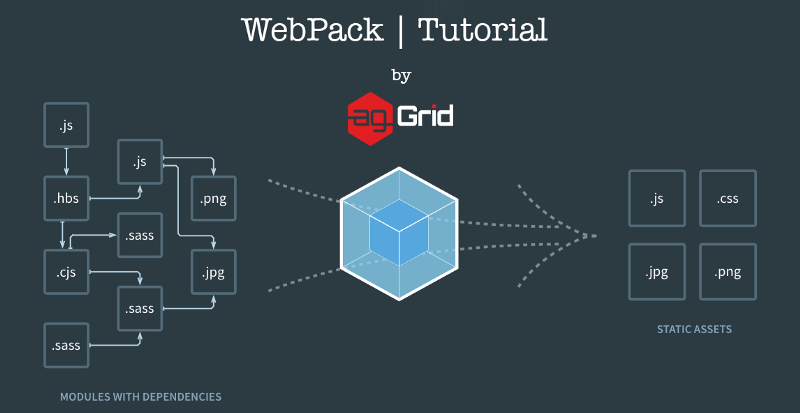In the ever-evolving landscape of web development, the build tool is the unsung hero, the powerful engine that transforms our modular, developer-friendly code into optimized, production-ready assets. While the community is abuzz with the latest Vite News and the promises of lightning-fast bundlers like Turbopack, it’s crucial not to overlook the established titan: Webpack. Far from being a relic, Webpack remains an incredibly powerful, flexible, and relevant tool, especially for complex, large-scale applications where granular control is not just a luxury, but a necessity.
The latest Webpack News isn’t always about groundbreaking speed; it’s about maturity, stability, and a vast ecosystem that can handle any edge case you throw at it. From powering enterprise-level applications built with React or Angular to enabling intricate build pipelines for game development with libraries like Phaser, Webpack’s configuration-driven approach provides unparalleled power. This article will dive deep into the modern Webpack ecosystem. We’ll revisit its core concepts, build a sophisticated configuration from scratch, explore advanced performance optimization techniques like code splitting and tree shaking, and discuss best practices to ensure your projects are lean, fast, and maintainable in 2024 and beyond.
The Enduring Core of Webpack: Why It Still Matters
At its heart, Webpack is a static module bundler. It takes your project’s modules (JavaScript files, CSS, images, etc.), figures out their dependencies, and generates static assets that a browser can understand. This core principle is powered by four key concepts: Entry, Output, Loaders, and Plugins.
Understanding the Four Pillars
1. Entry: This is the starting point of your application’s dependency graph. Webpack begins here to understand which other modules and libraries your application depends on. While you can have multiple entry points for different parts of an application (e.g., one for an admin panel and one for a user-facing site), a single entry point is common for Single Page Applications (SPAs).
2. Output: This tells Webpack where to emit the bundles it creates and what to name these files. The main output file is typically something like bundle.js or main.js, which is then included in your index.html.
3. Loaders: Out of the box, Webpack only understands JavaScript and JSON files. Loaders are what allow Webpack to process other types of files and convert them into valid modules that can be added to your dependency graph. For example, babel-loader transpiles modern JavaScript (ES6+) into browser-compatible ES5, and css-loader allows you to import CSS files directly into your JavaScript modules.
4. Plugins: While loaders work on a per-file basis, plugins are more powerful and can hook into the entire compilation lifecycle. They can perform a wide range of tasks, from bundle optimization and asset management to environment variable injection. A classic example is HtmlWebpackPlugin, which automatically generates an HTML file and injects your bundled scripts into it.
This modular and configurable nature is why Webpack is a cornerstone in the ecosystems of frameworks from React News to Vue.js News and even in the world of game development, as recent Phaser News demonstrates. Let’s see these concepts in a basic configuration.
// webpack.config.js
const path = require('path');
module.exports = {
// 1. Entry Point
entry: './src/index.js',
// 2. Output
output: {
filename: 'main.js',
path: path.resolve(__dirname, 'dist'),
clean: true, // Clean the output directory before each build
},
// 3. Loaders
module: {
rules: [
{
test: /\.js$/,
exclude: /node_modules/,
use: {
loader: 'babel-loader', // Use Babel to transpile JavaScript files
options: {
presets: ['@babel/preset-env'],
},
},
},
],
},
// 4. Plugins (we'll add these in the next section)
plugins: [],
};Modernizing Your Webpack Setup: From Zero to Hero
A basic configuration is a good start, but a modern development workflow requires more. We need a development server for live reloading, support for CSS and assets, and source maps for easier debugging. This is where the rich ecosystem of Webpack loaders and plugins truly shines.

Creating a Robust Development Environment
The webpack-dev-server provides a simple web server with live reloading capabilities. It makes the development feedback loop incredibly fast. We also need loaders to handle CSS (and pre-processors like Sass) and assets like images and fonts.
Let’s enhance our configuration for a modern development experience. This setup will include:
- webpack-dev-server: For a live-reloading development server.
- html-webpack-plugin: To generate our
index.htmlfile. - style-loader & css-loader: To handle CSS imports.
- Asset Modules: Webpack 5’s built-in way to handle images, fonts, and other assets without extra loaders.
This kind of setup is foundational for building applications with any modern framework, whether it’s Angular News, Svelte News, or even a custom setup with Lit News. The principles of handling different file types remain the same.
// webpack.config.js
const path = require('path');
const HtmlWebpackPlugin = require('html-webpack-plugin');
module.exports = {
mode: 'development', // Set mode to development for better debugging
entry: './src/index.js',
output: {
filename: 'bundle.js',
path: path.resolve(__dirname, 'dist'),
clean: true,
},
devtool: 'inline-source-map', // Add source maps for easier debugging
devServer: {
static: './dist', // Serve files from the dist directory
hot: true, // Enable Hot Module Replacement
},
plugins: [
new HtmlWebpackPlugin({
title: 'Modern Webpack App',
template: './src/index.html', // Use a template for the generated HTML
}),
],
module: {
rules: [
// JavaScript transpilation using Babel
{
test: /\.js$/,
exclude: /node_modules/,
use: {
loader: 'babel-loader',
options: {
presets: ['@babel/preset-env', '@babel/preset-react'], // Example for a React project
},
},
},
// CSS handling
{
test: /\.css$/i,
use: ['style-loader', 'css-loader'], // Order matters: css-loader -> style-loader
},
// Asset handling (images)
{
test: /\.(png|svg|jpg|jpeg|gif)$/i,
type: 'asset/resource',
},
// Asset handling (fonts)
{
test: /\.(woff|woff2|eot|ttf|otf)$/i,
type: 'asset/resource',
},
],
},
};This configuration provides a solid foundation. It uses the latest Babel News presets for modern JavaScript, handles CSS, and manages assets efficiently. It’s a setup that can power everything from a simple landing page to a complex desktop application using Electron News or Tauri News.
Advanced Webpack Techniques for Peak Performance
Once your application grows, so does your bundle size. Large JavaScript bundles can significantly slow down your site’s initial load time. Webpack provides powerful, built-in tools to combat this through code splitting and tree shaking.
Code Splitting for Faster Loads
Code splitting is the practice of splitting your code into various bundles which can then be loaded on demand or in parallel. This prevents loading a giant monolithic bundle on the initial page load. Webpack supports three main approaches:
- Entry Points: Manually split code using multiple
entrypoints. This is useful for separating vendor code from application code. - SplitChunksPlugin: A more automatic approach that can identify and extract common dependencies (like React or Lodash) into a shared “vendor” chunk.
- Dynamic Imports: The most powerful technique. Using the dynamic
import()syntax, you can load code on-demand, for example, when a user navigates to a new route or clicks a button to open a modal.
Here’s how you can use dynamic imports to lazy-load a module. This is a common pattern in frameworks like Next.js News and Remix News to optimize route transitions.
// src/index.js
const getComponent = async () => {
const element = document.createElement('div');
const button = document.createElement('button');
button.innerHTML = 'Click me to load the module!';
element.appendChild(button);
button.onclick = async (e) => {
// Dynamically import the module when the button is clicked
const { default: printModule } = await import('./print.js');
printModule();
};
return element;
};
document.body.appendChild(await getComponent());
// src/print.js
export default function printModule() {
console.log('This module was loaded dynamically!');
}Webpack will automatically see the import() syntax and create a separate chunk for print.js, which will only be fetched from the server when the user clicks the button.
Tree Shaking: Eliminating Dead Code
Tree shaking is the process of eliminating unused code from your final bundle. It relies on the static structure of ES2015 module syntax (import and export). When you import a function from a library but don’t use it, a production build with tree shaking enabled will remove that function from the final output.

To enable tree shaking, you need to:
- Use ES2015 module syntax.
- Set
"sideEffects": falsein your project’spackage.json, or specify files that have side effects. - Run Webpack in
productionmode, which automatically enables optimizations like minification and tree shaking.
Module Federation: The Micro-Frontend Revolution
One of the most exciting advancements in recent Webpack News is Module Federation. It allows a JavaScript application to dynamically load code from another application at runtime. This is the technology that powers many micro-frontend architectures, enabling different teams to build and deploy parts of a larger application independently. While a deep dive is beyond this article’s scope, it’s a testament to Webpack’s ability to solve complex, modern architectural challenges for frameworks like React News and Angular News.
Best Practices and Optimization Strategies
A well-tuned Webpack configuration can make a massive difference in your application’s performance and your team’s productivity. Here are some essential best practices.
Production-Ready Optimizations
For production builds, your focus should be on creating the smallest, fastest bundles possible.
- Minification: Use
TerserWebpackPlugin(for JavaScript) andCssMinimizerWebpackPlugin(for CSS) to minify your code. These are enabled by default inproductionmode. - Caching: Use content hashing in your output filenames (e.g.,
filename: '[name].[contenthash].js'). This ensures that browsers only re-download files when their content has actually changed, leading to much faster subsequent page loads. - Bundle Analysis: Use the
webpack-bundle-analyzerplugin to visualize the size of your output files. This is an invaluable tool for identifying large dependencies or opportunities for code splitting.
Here is a snippet showing how to configure caching and the bundle analyzer:
// webpack.prod.js (a production-specific config)
const { BundleAnalyzerPlugin } = require('webpack-bundle-analyzer');
module.exports = {
mode: 'production',
output: {
filename: '[name].[contenthash].js', // Use contenthash for long-term caching
path: path.resolve(__dirname, 'dist'),
clean: true,
},
optimization: {
// Automatically splits vendor code into a separate chunk
splitChunks: {
chunks: 'all',
},
},
plugins: [
// Add this plugin to analyze your bundle size
new BundleAnalyzerPlugin({
analyzerMode: 'static', // Generates an HTML report file
openAnalyzer: false, // Don't open it automatically
}),
],
// ... other production settings
};Webpack in the Modern Tooling Landscape
It’s impossible to discuss Webpack without acknowledging the broader ecosystem. Tools like Vite News, built on native ES modules, offer near-instantaneous development server start times. The latest Rollup News continues to show its strength in bundling libraries, while emerging Rust-based tools like Turbopack News and SWC News promise significant performance gains over their JavaScript-based counterparts like Babel News.
So, where does Webpack fit? The trade-off is often speed vs. control. Vite is exceptionally fast for development but uses Rollup for production builds, which has a different set of configurations and plugins. Webpack provides a consistent, albeit slower, environment for both development and production. For highly complex projects, such as those in the Three.js News community for 3D graphics, or large-scale enterprise apps built with NestJS News on the backend and a complex frontend, Webpack’s mature ecosystem and infinite configurability are often the deciding factor. It integrates seamlessly with testing frameworks like Jest News and Cypress News and is a core part of many established CI/CD pipelines.
Conclusion: The Power of Control
Webpack’s journey from a simple module bundler to a comprehensive build tool has been remarkable. While newer, faster tools have rightfully captured the community’s attention, Webpack’s strength has never been just about speed—it’s about power, flexibility, and a battle-tested ecosystem. Its ability to handle any asset, transform code in any way imaginable, and optimize bundles with surgical precision makes it an indispensable tool for developers tackling complex challenges.
Whether you’re building a micro-frontend architecture with Module Federation, optimizing a game’s asset pipeline, or simply maintaining a large legacy application, Webpack provides the control you need. By mastering its modern features—from code splitting and tree shaking to advanced caching strategies—you can ensure your applications are performant, scalable, and ready for the future. The next time you start a project, consider the trade-offs. If your priority is ultimate control and a mature, stable ecosystem, the latest Webpack News is that it remains a top-tier choice.

